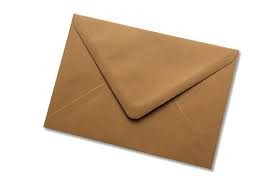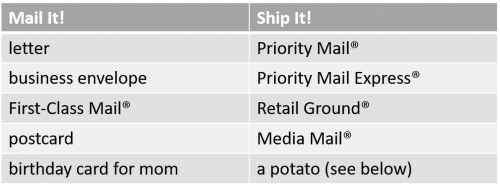Mailing vs Shipping Explained
|
August 2, 2018
|
Have you ever “addressed” an envelope?
What about “dropped a letter” in the mail?
How about “mailed a package”?
And what should you do with a potato? Actually, there’s a perfectly good answer, but we’ll get to that later.
Why are we asking so many questions? Well at some point, you’ve written out the address on an envelope. Maybe you’ve even dropped a letter in the mailbox and then peeked down the slot to see if your letter made it into the pile.
But we’re sure that you’ve never mailed a package. “Mailing a package” is one of those phrases in which the incorrect usage is so commonly used that it starts to make sense.
The terms “mailing” and “shipping” are used interchangeably, but they are different processes. Most people associate mail only with the United States Post Office® (USPS) and shipping with one of the many carriers, like FedEx® or UPS®.
Technically, you don’t mail a package. You ship it! Although your package might not ever see the inside of a ship.
If you run a business, whether small, mid-sized, or enterprise, it’s a really important distinction.
Let’s Break it Down:
Here’s the Confusion:
Even the USPS uses the phrase “mail a package.” They also use the tagline, “If it fits, it ships.” So you can use the USPS to mail letters and envelopes as well as shipping items in small packages or large packages, and things that fit inside tubes.
You can ship anything big enough for a package, as well as an oversized envelope that needs to be expedited.
To make things more confusing, when you use flat rate envelopes and boxes, those are considered shipping.
Ok, This Needs a Chart:
Here’s a handy chart that shows you at-a-glance what gets “mailed” and what gets “shipped.”

*Note: There are also maximum thickness limits on envelopes, so don’t overstuff! The maximum weight for First-Class Mail letters is 3.5 oz; and a maximum weight of 13 oz. for large First-Class Mail envelopes and parcels.
Luckily, you can save yourself a trip to the post office and get discounted rates on Priority Mail Flat Rate Envelopes and boxes by connecting your postage meter to online software.
Don't have a postage meter? Check out our postage meters here, especially if you’re still using stamps or an online postage service that involves a lot of steps and printer ink.
You’ll generally experience some of the most affordable mailing and shipping rates through the USPS. The USPS is usually less restrictive in regards to weight, size, quantity and type when compared to air transport. Shipping through postal services is now highly competitive with the cargo aircraft services, even though they have stayed “grounded.”
Still, shipping rates and delivery times are different across carriers. USPS, FedEx, and UPS each have their own benefits that can add value to your business, and you can use them to save money.
But I Want More Savings
We knew you’d say that!
You can save even more on shipping if you use S.M.A.R.T., our online shipping solution that analyzes the delivery schedules and rates of USPS®, FedEx® and UPS®, so you can choose the carrier that’s best for you and your individual shipments. Using S.M.A.R.T. gives you access to postage refunds and Commercial Base Pricing.
Plus you do it all online from your desktop, so you can upload addresses, track your shipments online, and keep everything moving from your own screen!
In Conclusion
Knowing the difference between mailing and shipping can help you: (1) save money, (2) choose the best delivery time and (3) access the best options. At Quadient, our mission is to take the guesswork out of mailing and shipping and provide hardware and software solutions to help you expand your options.
FYI…

Did you know that you can mail (actually, ship) a potato, as long as you write out the recipient and return address on the skin and then weigh it for proper postage. Any one of our Quadient meters can help you with that. We think Russet would be the best choice. Without special handling, you don’t want your spud to arrive mashed!
- Did You Know? (50)
- Mailing (148)
- News You Can Use (70)
- Opinion (3)
- Rate Change (57)
- Shipping (84)
- USPS (40)



